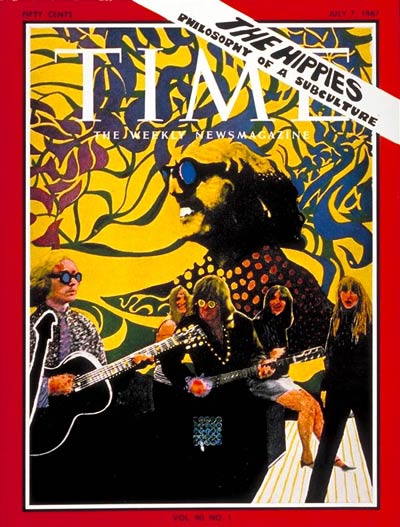
Milestone moments do not a year make. Often, it’s the smaller news stories that add up, gradually, to big history. With that in mind, in 2017 TIME History will revisit the entire year of 1967, week by week, as it was reported in the pages of TIME. Catch up on last week’s installment here.
When it comes to 1967, year of the summer of love, one image looms especially large in the American popular imagination: hippies.
And here they are, in a cover story that delved into the phenomenon that had kids dropping out, parents fretting, tourists heading to San Francisco to gawk and cultural observers wondering what it all meant. In the space of about a year and a half, they’d become “a wholly new subculture” with hippie hubs “blooming in every major U.S. city from Boston to Seattle, from Detroit to New Orleans” and maybe 300,000 people somehow connected to the movement.
But what exactly was the movement?
Difficult as it is to take precise bearings on the hippies, a few salient features stand out. They are predominantly white, middleclass, educated youths, ranging in age from 17 to 25 (though some as old as 50 can be spotted). Overendowed with all the qualities that make their generation so engaging, perplexing and infuriating, they are dropouts from a way of life that to them seems wholly oriented toward work, status and power. They scorn money—they call it “bread”—and property, and have found, like countless other romantics from Rimbaud to George Orwell, that it is not easy to starve. Above all, as New York’s Senator Robert Kennedy (“the best of a bad lot” to hippies) puts it: “They want to be recognized as individuals, but individuals play a smaller and smaller role in society. This is a formidable and forbidding arrangement.”
To alter that arrangement, the hippies hope to generate an entirely new society, one rich in spiritual grace that will revive the old virtues of agape and reverence. They reveal, says University of Chicago Theologian Dr. Martin E. Marty, “the exhaustion of a tradition: Western, production-directed, problem- solving, goal-oriented and compulsive in its way of thinking.” Marty refuses to put the hippies down as just another wave of “creative misfits,” sees them rather as spiritually motivated crusaders striking at the values of straight society where it is most vulnerable: its lack of soul. In a sense, hippiedom is a transplanted Lost Horizon, a Shangri-La a go-go blending Asian resignation and American optimism in a world where no one grows old.
It is in the hope of settling that precious state, and defining his position in it, that the hippie uses drugs—first for kicks and then sometimes as a kind of sacrament. Anti-intellectual, distrustful of logic, and resentful of the American educational process, the hippie drops out —tentatively at first—in search of another, more satisfying world.
The story isn’t short, but this is one where it’s probably worth reading the whole thing — or, at the very least, checking out the amazing six pages of color photos that accompany the story.
Another treat comes in the letter from the publisher, which reveals the outfits worn by TIME’s correspondents in an attempt to fit in while researching the hippies. Not everyone succeeded: “San Francisco Bureau Chief Judson Gooding was gauche enough to wear a suit and tie to a celebration in Golden Gate Park, and was suspected of being a ‘narco’ (narcotics agent).”
Spoiler alert: Here’s proof that spoilers are not a new problem. A reader wrote in to suggest that TIME’s “spoilsport [movie] reviewer should have the last reel withheld from him, ’cause old blabbermouth can’t resist giving away the story.”
A first: Though race relations in the U.S. were usually a serious concern for the magazine, this week offered the opportunity for a more optimistic kind of story, as Major Robert H. Lawrence Jr. was picked to be the nation’s first African-American astronaut.
Powerful painters and body shamers: Two items on this week’s “People” page are clear parallels for modern news. First, there are paintings by President Dwight D. Eisenhower; President George W. Bush’s oil paintings were compiled in a book earlier this year. And though the idea of body shaming may be something for the Instagram era, that’s what model Twiggy’s mom was speaking out about when she told the press that a doctor who hadn’t actually treated her daughter was spouting “rubbish” when he said she looked unhealthy.
Canines on the couch: Also in the realm of “things you thought were invented more recently,” here’s an exploration of the burgeoning 1960s world of psychotherapy for dogs.
Great vintage ad: This week in technology that never really took off, here are bottles that require no opener — but because they have ring-pull tabs, not because they twist off.
Coming up next week: The King of Jordan
More Must-Reads From TIME
- The 100 Most Influential People of 2024
- Coco Gauff Is Playing for Herself Now
- Scenes From Pro-Palestinian Encampments Across U.S. Universities
- 6 Compliments That Land Every Time
- If You're Dating Right Now , You're Brave: Column
- The AI That Could Heal a Divided Internet
- Fallout Is a Brilliant Model for the Future of Video Game Adaptations
- Want Weekly Recs on What to Watch, Read, and More? Sign Up for Worth Your Time
Write to Lily Rothman at lily.rothman@time.com